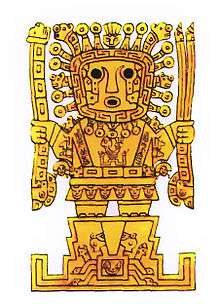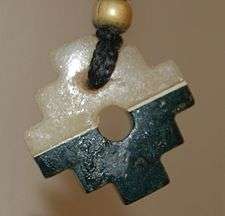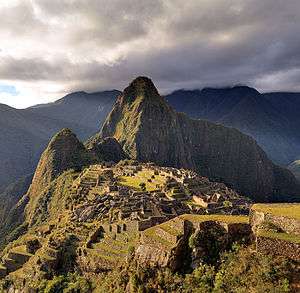Inca mythology
Inca mythology includes many stories and legends that attempt to explain or symbolize Inca beliefs.[1]
Basic beliefs
Ethnographic and anthropological studies such as Prof. Gary Urton's demonstrate that Inka believe systems were inter-related to their view of the cosmos, in particular the way that they observed the motions of the portion of the milky way and planets of the solar system as seen from the Cusco or Qosqo (their capital whose meaning is 'the centre of the earth'). From this perspective their stories depict the movements of constellations, planets, planetary formations, which are connected to their agricultural cycles for a society that relied on cyclical agricultural seasons, which were not only connected to year cycles (as in Europe) but to a much wider cycle of time (every 800 years at a time). This was the main tool to ensure cultural transmission of key information, in spite of regime change or social catastrophes.
The Inca myths have been interpreted from a Eurocentric perspectives, this is detached from cosmology and agriculture, depriving of its richness and practical ancient functionality.
All those that followed the Spanish conquest of the Inca Empire by Francisco Pizarro burned the records kept by the Inca culture. There is currently a theory put forward by Gary Urton that the Quipus could have represented a binary system capable of recording phonological or logographic data. Still, to date, all that is known is based on what was recorded by priests, from the iconography on Incan pottery and architecture, and from the myths and legends that have survived among the native peoples.
Inca foundation legends

Manco Cápac the legendary founder of the Inca Dynasty in Peru and the Cusco Dynasty at Cusco. The legends and history surrounding this mythical figure are very jumbled, especially those concerning his rule at Cuzco and his birth or his origins respectively. In one legend, he was the son of Tici Viracocha. In another, he was brought up from the depths of Lake Titicaca by the sun god Inti. However, commoners were not allowed to speak the name of Inca Viracocha, which is possibly an explanation for the need for three foundation legends rather than just the first.[2]
There were also many myths about Manco Cápac and his coming to power. In one myth, Manco Cápac and his brother Pacha Kamaq were sons of the sun god Inti. Manco Cápac, himself, was worshiped as a fire and sun god. In another myth, Manco Cápac was sent with Mama Ocllo (others even mention numerous siblings) to Lake Titicaca where they resurfaced and settled in Isla Del Sol, Bolivia. According to this Inti legend, Manco Cápac and his siblings were sent up to the earth by the sun god and emerged from the cave of Puma Orco at Paqariq Tampu carrying a golden staff called ‘tapac-yauri’. They were instructed to create a Temple of the Sun in the spot where the staff sank into the earth to honor the sun god Inti, their father. During the journey, one of Manco's brothers (Ayar Cachi) was tricked into returning to Puma Urqu and sealed inside, or alternatively was turned to ice, because his reckless and cruel behavior angered the tribes that they were attempting to rule. (huaca).
In another version of this legend, instead of emerging from a cave in Cuzco, the siblings emerged from the waters of Lake Titicaca. Since this was a later origin myth than that of Pacaritambo it may have been created as a ploy to bring the powerful Aymara tribes into the fold of the Tawantinsuyo.
In the Inca Virachocha legend, Manco Cápac was the son of Inca Viracocha of Paqariq Tampu which is 25 km (16 mi) south of Cuzco. He and his brothers (Ayar Auca, Ayar Cachi, and Ayar Uchu); and sisters (Mama Ocllo, Mama Huaco, Mama Raua, and Mama Cura) lived near Cusco at Paqariq Tampu, and uniting their people and the ten ayllu they encountered in their travels to conquer the tribes of the Cusco Valley. This legend also incorporates the golden staff, which is thought to have been given to Manco Cápac by his father. Accounts vary, but according to some versions of the legend, the young Manco jealously betrayed his older brothers, killed them, and then became Cusco.
Deities

Like the Romans, the Incas permitted the cultures they integrated into their empire to keep their individual religions. Below are some of the various gods worshiped by the peoples of the Incan empire, many of which have overlapping responsibilities and domains. Unless otherwise noted, it can safely be assumed these were worshipped by different ayllus or worshipped in particular former states.[3]
- Apu was a god or spirit of mountains. All of the important mountains have their own Apu, and some of them receive sacrifices to bring out certain aspects of their being. Some rocks and caves also are credited as having their own apu.[4]
- Apocatequil (aka Apotequil) or Illapa was the god of lightning.
- Ataguchu was a god who assisted in creation myth.
- Catequil was a god of thunder and lightning.
- Cavillace was a virgin goddess who ate a fruit, which was actually the sperm of Coniraya, the moon god. When she gave birth to a son, she demanded that the father step forward. No one did, so she put the baby on the ground and it crawled towards Coniraya. She was ashamed because of Coniraya's low stature among the gods, and ran to the coast of Peru, where she changed herself and her son into rocks.
- Ch'aska ("Venus") or Ch'aska Quyllur ("Venus star") was the goddess of dawn and twilight, the planet
- Coniraya was the moon deity who fashioned his sperm into a fruit, which Cavillaca then ate.
- Copacati was a lake goddess.
- Ekkeko was a god of the hearth and wealth. The ancients made dolls that represented him and placed a miniature version of their desires onto the doll; this was believed to caused the user to receive what he desired.
- Illapa ("thunder and lightning"; aka Apu Illapu, Ilyap'a, Katoylla) was a very popular weather god. His holiday was on July 25. He was said to keep the Milky Way in a jug and use it to create rain. He appeared as a man in shining clothes, carrying a club and stones. He was formerly the main god of the Kingdom of Qulla after which the Qullasuyu province of the Inca Empire was named.
- Inti was the sun god. Source of warmth and light and a protector of the people. Inti was considered the most important god. The Inca Emperors were believed to be the lineal descendants of the sun god.
- Kon was the god of rain and wind that came from the south. He was a son of Inti and Mama Quilla.
- Mama Allpa was a fertility goddess depicted with multiple breasts.
- Mama Qucha ("sea mother") was the sea and fish goddess, protectress of sailors and fishermen. In one legend she mothered Inti and Mama Killa with Wiraqucha.

- Mama Pacha (aka Pachamama) literally translates to "mother nature" and was the most important figure in mythology, second only to the Sun. She was the wife of Pacha Kamaq, a dragon, and a fertility deity who presided over planting and harvesting. She caused earthquakes.
- Mama Killa ("mother moon" or "golden mother") was a marriage, festival and moon goddess and daughter of Wiraqucha and Mama Qucha, as well as wife and sister of Inti. She was the mother of Manqu Qhapaq, Pacha Kamaq, Kon and Mama Uqllu.
- Mama Sara ("maize mother", aka Saramama) was the goddess of grain. She was associated with maize that grew in multiples or were similarly strange. These strange plants were sometimes dressed as dolls of Mama Sara. She was also associated with willow trees.
- Pacha Kamaq ("Earth-maker") was a chthonic creator god, earlier worshiped by the Ichma but later adopted into the creation myth of the Inca.
- Paryaqaqa was a god of water in pre-Inca mythology that was adopted by the Inca. He was a god of rainstorms and a creator-god. He was born a falcon but later became human.
- Paricia was a god who sent a flood to kill humans who did not respect him adequately. Possibly another name for Pacha Kamaq.
- Supay was both the god of death and ruler of the Uku Pacha as well as a race of demons.
- Urcaguary was the god of metals, jewels and other underground items of great value.
- Urquchillay was a deity that watched over animals.
- Wiraqucha was the god of everything. In the beginning he was the main god, but when Pachakuti became Inca emperor, he changed this god's importance, pointing out that the most important god was Inti.
Important beliefs
- Mama Uqllu was the sister and wife of Manqu Qhapaq. She was thought to have taught the Inca the art of spinning.
- Mamaconas were similar to nuns and lived in temple sanctuaries. They dedicated their lives to Inti, and served the Inca and priests. Young girls of the nobility or of exceptional beauty were trained for four years as acllas and then had the option of becoming mamaconas or marrying Inca nobles. They are comparable to the Roman Vestal Virgins, though Inca society did not value virginity as a virtue the way Western societies have done throughout history.
- In one legend, Unu Pachakuti was a great flood sent by Virachocha to destroy the giants that built Tiwanaku.
- A Wak'a was a sacred object such as a mountain or a mummy.
Important places
Inca cosmology was ordered in three spatio-temporal levels or Pachas.[5] These included:
- Uku Pacha ("the lower world") was located within the earth's surface.
- Kay Pacha was the world in which we live.
- Hanan Pacha ("higher world") was the world above us where the sun and moon lived.[6]
Inca symbols

- Chakana (or Inca Cross, Chakana) is - according to some modern authors - the three-stepped cross equivalent symbolic of what is known in other mythologies as the Tree of Life, World Tree and so on. Through a central axis a shaman journeyed in trance to the lower plane or Underworld and the higher levels inhabited by the superior gods to enquire into the causes of misfortune on the Earth plane. The snake, puma, and condor are totemic representatives of the three levels. The alleged meaning of the chakana symbol is not supported by scolarly literature.
See also
Sources
- ↑ Handbook of Inca Mythology by Paul Richard Steele, Catherine J. Allen
- ↑ The History of the Incas by Pedro Sarmiento De Gamboa, Brian S. Bauer, Vania Smith
- ↑ Roza, Greg (2008). Incan Mythology and Other Myths of the Andes. The Rosen Publishing Group, Inc.
- ↑ Sacred Mountain Expedition: April 2007
- ↑ Heydt-Coca, Magda von der (1999). "When Worlds Collide: The Incorporation Of The Andean World Into The Emerging World-Economy In The Colonial Period". Dialectical Anthropology. 24 (1): 1–43.
- ↑ Steele, Richard James (2004). Handbook of Inca Mythology. ABC-CLIO.
